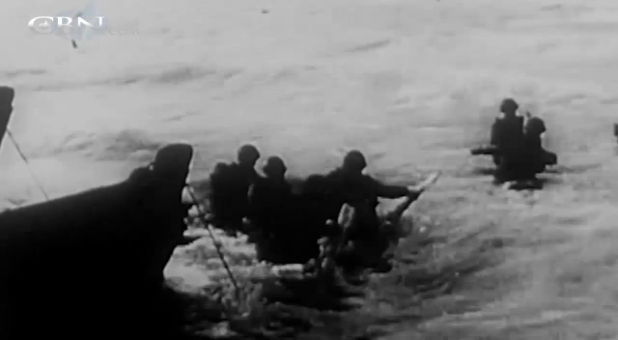Remembering D-Day 70 Years Later
Seventy years ago on June 5, 1944, Allied forces set out to invade Nazi occupied France on beaches of Normandy. But bad weather and high seas would delay the invasion for another day. U.S. Navy Seaman, Charles “Buster” Shaeff remembers when the order came.
Seaman Shaeff: “By the time we were moving the second time, we had a pretty good idea where we were going.”
Across the English Channel lay Hitler’s heavily fortified Atlantic wall. Field Marshal Erwin Rommel had built defenses to crush an allied invasion on the beaches. On Normandy alone 6 million mines, hedgehogs, and Rommel’s so called “asparagus” carpeted the beach.
April Cheek-Messier: “Which is one reason the troops had to land at low tide. The problem with that, of course, is being you have twice as much wide-open beach to cross as a result.”
Historical expert April Cheek-Messier is president of the National D-day Memorial in Bedford, Virginia.
Cheek-Messier: “These German bunkers with German machine guns and weapons that could reach throughout the beaches. They overlapped every single inch of beach. Those guns could reach ten miles out into the channel.”
As the Commanders readied their troops for the invasion, prayer was a vital part of the mission.
Cheek-Messier: The chaplains who came and talked to them and who were with them in those hours leading up to the invasion, many of them were certainly thinking of their faith and were certainly saying their prayers to God that they would make it through this.
The 6th of June. D-day. The Allied invasion begins.
Cheek-Messier: “If you were to look up in the skies on D-day, you would’ve seen airplanes flying wing tip to wing tip: 5,000 ships, 11,000 aircraft, and 150,000 troops just on D-day.”
Ten miles off the coast of Normandy, 30,000 soldiers from the 2nd Ranger Battalion boarded Seaman Shaeff’s assault landing craft. They were headed for Omaha beach.
Shaeff: “They were anxious to get to the beach. It became daylight on the way in, and we hit the beach about five minutes after H-hour.”
Cheek-Messier: “Some of them in waist deep water or higher carrying 100 pounds of equipment, struggling to get ashore, struggling to find cover.
They called it “bloody Omaha”. The terrain was just a natural defense there with the Germans on these cliffs. They were 100 feet up. They had a direct line of fire as these troops were coming in on their landing crafts.”
But, the soldiers kept going.
Shaeff: “They had their orders as to what they were going to do. They had to climb the cliffs at Point du Hoc and get at the Germans that way.”
Cheek-Messier: “Those large guns had to be found and destroyed for the invasion to succeed. So they had to climb those cliffs using ropes and disable those weapons.”
The invasion stretched across 50 miles of the French coastline. Seaman Shaeff and crew carried three groups of Army Rangers from ship to shore. Each round trip took about six hours.
Shaeff: “With a full load, we only could make about three knots.”
David Kithcart reporting: “So, you were a slow moving target?”
Shaeff: “Very slow moving. We basically ignored the difficulties. And we had a job to do and we worked on it. It was one of those things that you just stayed with it.”
On their 3rd and final run ashore, Shaeff’s landing craft hit a hedgehog (military obstacle). The boat sank, but was in shallow water and all four crewmen to made it to safety.
Shaeff: “I was extremely lucky.”
Afterwards, the beaches called Juno, Sword, Gold and Omaha, names that are familiar to us now, were awash in metal and blood.
Victory came a high price. Four thousand, four hundred and thirteen Allied troops were lost.
(Kithcart on location): The National D-day Memorial, here in Bedford, Virginia, was erected with private funds in honor of the fallen. These waterspouts behind me are symbolic of the gunfire the allies faced as they stormed the beaches of Normandy.
Cheek- Messier: “A tremendous sense of loss of what happened that day. But really what we have to look at was what was gained. And what was gained that day were the beaches, and then a village, and then a country, and then all of Western Europe. D-day was the watershed event of WWII, and it was the turning point. It was the beginning of the end of Hitler’s dreams of Nazi domination.”
But what if D-day had failed?
Cheek-Messier: “Certainly Hitler’s final solution would have been complete. Hitler would’ve developed more technology: His v-1 rockets, his new jet aircrafts that he was developing, and even the atomic—atomic weapons. Any way you look at it the consequences would have been dire. That’s why it’s so critical that we pay tribute and historically remember on these occasions why we’re here today.”
Seaman Shaeff, now 89, wants the world to remember that D-day marks the start where freedom was reclaimed for generations yet to come.
Kithcart: “That was a day of days.”
Shaeff: “It was a busy day.”
Tomorrow marks the 70th anniversary of D-day. National D-day Memorial stands as a reminder of the sacrifices given by a few for so many.
Cheek-Messier: “Veterans like Seaman “Buster” Shaeff, who are so humble about their experiences; they were simply doing their jobs.”
Shaeff: “I guess in some ways when you look at the whole thing up there, it sort of scares me as to what I’ve been through. But the Good Lord was with me. And still is.”















































